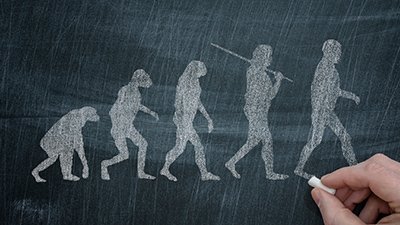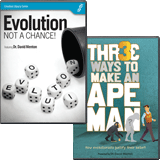TIME to Stay Current on Human Origins
It seems like evolution is always in the news. Whether it is a new dinosaur skeleton, a new fossil hominid or alleged genetic links between different species, evolution is frequently in the media. As I write this, evolution and humans’ alleged ape ancestry is on the cover of TIME—again!
This time the cover boasts, “How we became human.” This is an interesting contrast to a TIME cover from July 23, 2001, which said “How Apes Became Human.” In spite of the attention grabbing headline, neither issue actually explains how we (or apes) became human.
It seems like evolution is in the news now more than ever. In part, this is probably because of the strides that creationists have been making. More people than ever are becoming informed about the evidence that supports the creation account in Genesis and calls into question evolutionary theory. Perhaps because of that, there is even more of an effort to “educate” the public on the evidence for evolution.
If you stay informed on these issues from a creation standpoint, they can provide excellent talking points with friends and relatives. These can serve as conversation starters that can open the door to sharing about your belief in creation and your relationship with Christ.
As a case in point, many of the evidences that were used in this TIME article1 have been discussed in a series of articles that are already on the Answers in Genesis website. These articles provide additional information about the topic and reveal the evolutionary assumptions that are involved in analyzing the data.
Similarity does not provide evidence of a common ancestor—it only provides evidence that the two organisms are similar.
For example, the TIME article begins by discussing how similar humans and the great apes are. However, similarity does not provide evidence of a common ancestor—it only provides evidence that the two organisms are similar. Common ancestry is assumed. To reinforce the claim, TIME says that humans and chimps have 98–99% identical DNA. This is in part based on the completed draft sequence of the chimpanzee genome.
However, this is misleading because it ignores many important differences. These differences were discussed in “Chimp Genome Sequence Very Different from Man.” Although chimpanzees have 24 pairs of chromosomes and humans have 23, there are many significant differences. In fact, when the chimpanzee sequence was reported in Nature, they said that the percent similarity was 96%. Although 1.23% of the differences were single DNA base pair changes, more than twice that number were extra DNA bases that were found either in chimpanzees or humans. TIME conveniently left the percentages of the extra DNA out so that they could keep the difference at 98–99% based on only the single base pair changes. The use of a percentage also obscures the fact that it is at least roughly 125 million DNA base pairs that are different between the two species. To put the number into perspective, I am currently finishing writing a book. With 190 pages there are only ~300,000 letters in the book. It would take 400 such books just to equal the differences between chimps and humans.
Another misleading claim in the article is about FOXP2, a protein that appears to play a role in language. This protein has been shown to be required for normal development of neurons that are involved in controlling the process of vocalization. TIME reports:
By comparing the protein coded by the human FOXP2 gene with the same protein in various great apes and in mice, they discovered that the amino-acid sequence that makes up the human variant differs from that of the chimp in just two locations out of a total of 715—an extraordinarily small change that may nevertheless explain the emergence of all aspects of human speech, from a baby's first words to a Robin Williams monologue.
Thus it would seem that if those two differences were changed in chimpanzees, we would be able to have a nice conversation with them. But even one of the authors of the original work on FOXP2 has been careful to say that this should not be considered “the language gene.” Nonetheless, this is how it is portrayed by TIME. In “FOXP2 and the Non-Evolution of Human Language” I cut through some of the media hype to put the results into perspective. Also not mentioned in the TIME article is the fact that the FOXP2 protein has only one difference between chimpanzees and mice.
Yet another misleading evidence in the TIME article is the idea that a mutation in a jaw muscle protein allowed the brain to increase in size. The mutation causes bundles of muscle fibers to be smaller and indeed humans have smaller relative jaw muscles than the apes. This shrinking of the jaw muscle is supposed to have provided the space for the brain to increase. The claim has been somewhat in dispute among evolutionists.
In an article in TJ, “Did a Jaw Muscle Protein Mutation Lead to Increased Cranial Capacity in Man?” numerous problems with this hypothesis were discussed, not the least of which is that the brain size is not limited by the skull but instead it is the size of the brain that makes a difference in the skull.2 This is demonstrated by microcephaly, where a mutation in a brain protein causes the brain to be abnormally small, and the skull shrinks accordingly. Also, with hydrocephalus, brain volume is abnormally increased and the skull can be correspondingly larger.
TIME magazine also mentioned the exotic claim that chimpanzees and humans may have interbred. Under the heading “Sex with chimps?” TIME discusses the controversial claim that humans and chimpanzees split and then later interbred for a time. This example was critiqued in “Chimp-Human Hybridization: Two of a Kind or Two Different Kinds?”
On the fossil hominid front, the article mentions Sahelanthropus and Ardipithicus. Sahelanthropus is supposed to be the oldest human ancestor, dated at 6–7 million years. One of the problems with this fossil is that even other evolutionists consider it to be a type of ape. In “The Toumaï Skull: Ape or Human Ancestor?” Marvin Lubenow discussed the problems in identifying this specimen as a human ancestor. Several other articles have discussed the claims, including the fact that the features that are supposed to make the specimen more human-like are sexually dimorphic in apes. Thus, it appears to be similar to a female gorilla.
Ardipithicus ramidus kadabba was featured on the cover of the July 23, 2001, issue of TIME. Inside was a picture of a fossil toe with the caption, “This toe bone proves that the creature walked on two legs.” The evidence in favor of this is the joint surface. However, the bone is long and curved like that of a chimpanzee. This has led David Begun of the University of Toronto to say, “To me, it looks for all the world like a chimpanzee foot phalanx [toe bone].”3
The article also discusses the Neandertals. Currently, scientists are working very hard to try to obtain the DNA sequence of the entire Neandertal genome. I am very eager to see this data, as I expect it to vindicate the human status of Neandertals. Neandertals played musical instruments, used jewelry and buried their dead with ceremonies—decisively human characteristics. Numerous articles on Neandertals are available on the Answers in Genesis website. There is also the video Did Neanderthals and Modern Humans Share a Recent Common Gene Pool? from the 2003 creation conference.
Noticeably absent from the TIME magazine article was mention of Lucy, the famous australopithecine. Just over a week ago, a new specimen of Lucy’s kind was making headlines. This mostly complete, well-preserved fossil was that of a ~3-year-old and has been named Selam. However, essentially all of the new features that were discerned from this specimen aligned it more closely with apes and chimpanzees. “Lucy and Her ‘Child’ Look Like Extinct Apes After All” discussed the significance of this find to creationists. Perhaps the reason that Selam was not mentioned in the TIME article is precisely because it now shows how ape-like the australopithecines were.
As you can see, with evolution-refuting resources available on the internet, it is no wonder that evolutionists are frantic to push evolution through the mainstream media. There is a battle going on and it is over the hearts and minds of people. One side is pushing the idea that humans are just animals—the product of millions of years of random mutations. The other side affirms what the Bible holds—that man was uniquely created in the image of God.
Footnotes
- Michael D. Lemonick and Andrea Dorfman, “What Makes Us Different,” TIME, October 1, 2006, http://content.time.com/time/magazine/article/0,9171,1541283,00.html.
- David A. DeWitt, “Did a Jaw Muscle Protein Mutation Lead to Increased Cranial Capacity in Man?,” Journal of Creation 19, no. 1 (April 2005): 88-96.
- Kate Wong, “An Ancestor to Call Our Own,” Scientific American, January 2003, 59, http://www.ucd.ie/artspgs/langevo/ancestor.pdf.
Recommended Resources

Answers in Genesis is an apologetics ministry, dedicated to helping Christians defend their faith and proclaim the good news of Jesus Christ.
- Customer Service 800.778.3390
- © 2025 Answers in Genesis






